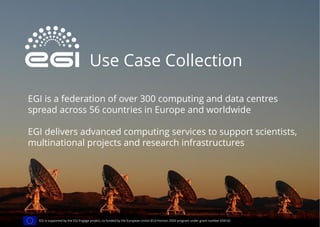Use cases collection
- 1. Use Case Collection EGI is a federation of over 300 computing and data centres spread across 56 countries in Europe and worldwide EGI delivers advanced computing services to support scientists, multinational projects and research infrastructures EGI is supported by the EGI-Engage project, co-funded by the European Union (EU) Horizon 2020 program under grant number 654142
- 2. Research Infrastructures and Large Research Collaborations
- 3. In 2016, the Worldwide LHC Computing Grid (WLCG) transferred on average 80 Petabytes of data per month. This corresponds to more than 1 billion files per month transferred to thousands of particle physicists working across the world. ATLAS control room at CERN WLCG provides computing and storage to the High Energy Physics experiments operating at CERNâs Large Hadron Collider WLCG: Online Storage and Data Transfer at unprecedented scales
- 4. 1350 scientists from 32 countries CTA EGI usage (2013-2016): âĒ 360 million HS06 CPU hours âĒ 11 PB of data transferred âĒ 2 PB currently in storage âĒ 11 million compute jobs Credit: Akihiro Ikeshita Mero-TSK CTA uses EGIâs High-Throughput Compute and Online Storage services to manage its computational challenges during the array preparatory phase. http://go.egi.eu/cta Cherenkov Telescope Array: the worldâs leading gamma-ray observatory
- 5. 240 scientists from 14 countries H.E.S.S. EGI usage (per year): âĒ 38 million HS06 CPU hours âĒ 2,000 compute jobs running at any given timeCredit: Julien Bolmont / Collaboration HESS / CNRS PhotothÃĻque H.E.S.S. uses EGIâs High-Throughput Compute service to run massive Monte Carlo simulations from the data collected in their observatory in Namibia. http://go.egi.eu/hess H.E.S.S. Experiment: a window to the high energy universe
- 6. Applications, tools and platforms for science (Thematic Services)
- 7. For modelling the structure of proteins and other molecules Scientists input their data and specifications; HADDOCK returns best fit simulations. So far, HADDOCK processed over 130,000 submissions from more than 7,500 scientists. HADDOCK portal â Structural Biology HADDOCK relies on EGIâs High-Throughput Compute service https://www.egi.eu/use-cases/scientific-applications-tools/haddock/
- 8. For medical simulation and image data analysis VIP allows life scientists to use complex computational tools with no added IT overhead. VIP portal â Medical Imaging VIP relies on EGIâs High-Throughput Compute service and the DIRAC instance provided by France Grilles http://go.egi.eu/vip
- 9. http://chipster.csc.fi/ Chipster - Bioinformatics Research story: http://go.egi.eu/BIBD For genomic analysis A user-friendly analysis software for high-throughput data with over 350 analysis tools and a large collection of reference genomes Users can save and share automatic analysis workflows, and visualize data interactively
- 10. Individual scientists and research groups (the so-called Long-Tail of Science)
- 11. When human cell meets Salmonella K. FÃķrstner (Univ. WÞrzburg) used Cloud Compute to run READemption - a pipeline for the analysis of sequencing data. Cloud Compute helped the team to handle demand peaks and that sped up the whole process significantly. Published in Nature (doi:10.1038/nature16547) Understanding the genetics of Salmonella infections http://go.egi.eu/salm
- 12. Chipster helps virologists to understand millions of genomes J. Hepojoki (Univ. Helsinki) used Chipster to analyse the viruses found in six snakes suffering from Boid Inclusion Body Disease. They found that all samples had more than one arenavirus, some of them from entirely new species. Published in Journal of Virology (doi:10.1128/JVI.01112-15) New viruses implicated in fatal snake disease http://go.egi.eu/BIBD
- 13. How bacteria steal iron from plant proteins https://www.egi.eu/use-cases/research-stories/iron-piracy/ HADDOCK shows how iron pirates operate R. Grinter (Monash Univ.) used the HADDOCK portal to understand the structure of FusA, a receptor in bacterial cells designed to grab and steal iron from plant proteins http://haddock.science.uu.nl/ Published in Nature Communications (doi:10.1038/ncomms13308)
- 14. EGI Foundation âĒ Science Park 140 âĒ 1098 XG Amsterdam The Netherlands +31 (0)20 89 32 007 âĒ www.egi.eu @EGI_eInfra Get in touch!
- 15. Visit https://www.egi.eu/ Services https://www.egi.eu/services/ Publications https://www.egi.eu/about/publications/ Contact us: â For public institutions: contact@egi.eu â For private organisations: business@egi.eu Discover more















